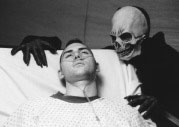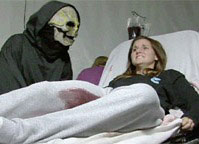Hell House: It'll Really Scare the Hell Out of You 
Hell House is a haunted theme park featuring gory, gruesome, and sensationalized dioramas of sinners and their fate, whether it’s a last-minute redemption or an eternity burning in the fires of Hell. Starting in 1990, Trinity Church, an Assembly of God parish in Cedar Hill, Texas, has been executing their haunted house scenario, an event designed to instill fear and to bring the “lost” into the folds of the Church. Following in Trinity’s footsteps, dozens of churches all over the country have followed suit, presenting the horrors of sin and the fate of sinners who won’t accept Jesus Christ as their personal savior.
Trinity drew a great deal of national attention in 1999 when their haunted house featured a reenactment of the Columbine High School massacre. While some of the church members lament the negative portrayal they received in the press, they agree that Hell House is a key event in the church’s arsenal. Not only does it bring in a great deal of money; they also reach thousands of young people every year who wouldn’t otherwise walk through the doors of their church.
 His curiosity aroused by the controversy surrounding the Columbine theme, documentary filmmaker George Ratliff contacted the church and told them of his interest in telling “their side of the story.” While it took a little coaxing—Trinity Church hasn’t thought much of the treatment they’ve received from the media—they ultimately agreed. Ratliff spent the month of October filming as the church parishioners studied scripts, auditioned for roles, built structures, and finally opened the doors to their tenth anniversary haunted house.
His curiosity aroused by the controversy surrounding the Columbine theme, documentary filmmaker George Ratliff contacted the church and told them of his interest in telling “their side of the story.” While it took a little coaxing—Trinity Church hasn’t thought much of the treatment they’ve received from the media—they ultimately agreed. Ratliff spent the month of October filming as the church parishioners studied scripts, auditioned for roles, built structures, and finally opened the doors to their tenth anniversary haunted house.
Ratliff’s is surprisingly evenhanded in his portrayal of the Cedar Hill community and the members of Trinity Church. In one scene, the filmmaker allows himself a moment of commentary. After the church leaders are seen arguing about whether or not Satanists would use white paint or red for their ritual pentagram, the camera pans to the finished product: a red Star of David spray painted on a black background.
Throughout the rest of the film, Ratliff allows the church to tell the story on its own terms. Parents support their children by showing up for auditions for parts such as “abortion girl,” “suicide girl,” and “raped at the rave girl” as though this was yet another production of Annie.
There are moments where you begin to wonder what exactly Ratliff is up to. In one overlong sequence, we follow John Cassar—a single father whose daughter will try out for and ultimately win the role of “abortion girl”—through the day, starting at 6 a.m. Life is hard for this father of five, but it’s clear that he loves his children, from his nagging the oldest for taking so much time in the bathroom, to his quick response when his youngest child is in the throws of a seizure.
 While this peek into the daily life of the Cassar family seems a little odd, it only gets stranger as the viewer learns that his wife is “no longer with us” as she left her husband and children for a chat room lover only a few years earlier. This anecdote gets stranger still as it becomes clear that one of the themes of this year’s Hell House is a family situation where a drunken, abusive husband discovers that his wife has been arranging secret rendezvous via the Internet. Dad takes time out of his own busy schedule as a tour guide to stand back and watch this particular story unfold. That scene—watching Cassar watching a scene from his life unfold—is one of the creepiest in the entire film.
While this peek into the daily life of the Cassar family seems a little odd, it only gets stranger as the viewer learns that his wife is “no longer with us” as she left her husband and children for a chat room lover only a few years earlier. This anecdote gets stranger still as it becomes clear that one of the themes of this year’s Hell House is a family situation where a drunken, abusive husband discovers that his wife has been arranging secret rendezvous via the Internet. Dad takes time out of his own busy schedule as a tour guide to stand back and watch this particular story unfold. That scene—watching Cassar watching a scene from his life unfold—is one of the creepiest in the entire film.
In another sequence, a recovering rave DJ tells his own story of the evils of the rave scene, emphasizing the importance of reaching out to a younger generation through the images of rave to illustrate the dangers of the scene. He fixates on the details—what kind of music, what kind of clothes, what kind of glow-in-the-dark graffiti on the walls. One can’t help but feel that, while he’s found religion (although he clearly kept all of his rave music T-shirts), he misses the scene so much that he can’t wait for that once-a-year reenactment to relive the joyous abandon of his former life.
Chances are this film won’t sway you one way or another. If you think that this hellfire and brimstone approach to spirituality makes any kind of sense, you’ll find a lot to agree with as church leaders go on about sin and redemption while trying to figure out if that occult card game is called “Magick,” “The Gathering,” or “Magick: The Gathering.” Word has it that the parishioners think it’s a great film, showing their community in a folksy, well-meaning, home movie sort of way. They even laughed at parts.
On the other hand, if you think this is the work of a bunch of overwrought zealots, you’ll be laughing, too. But it will be that uncomfortable sort of laugh brought about by sheer disbelief at the ignorant self-righteousness of a group that knows that they are the only ones who really know the true message of God.
